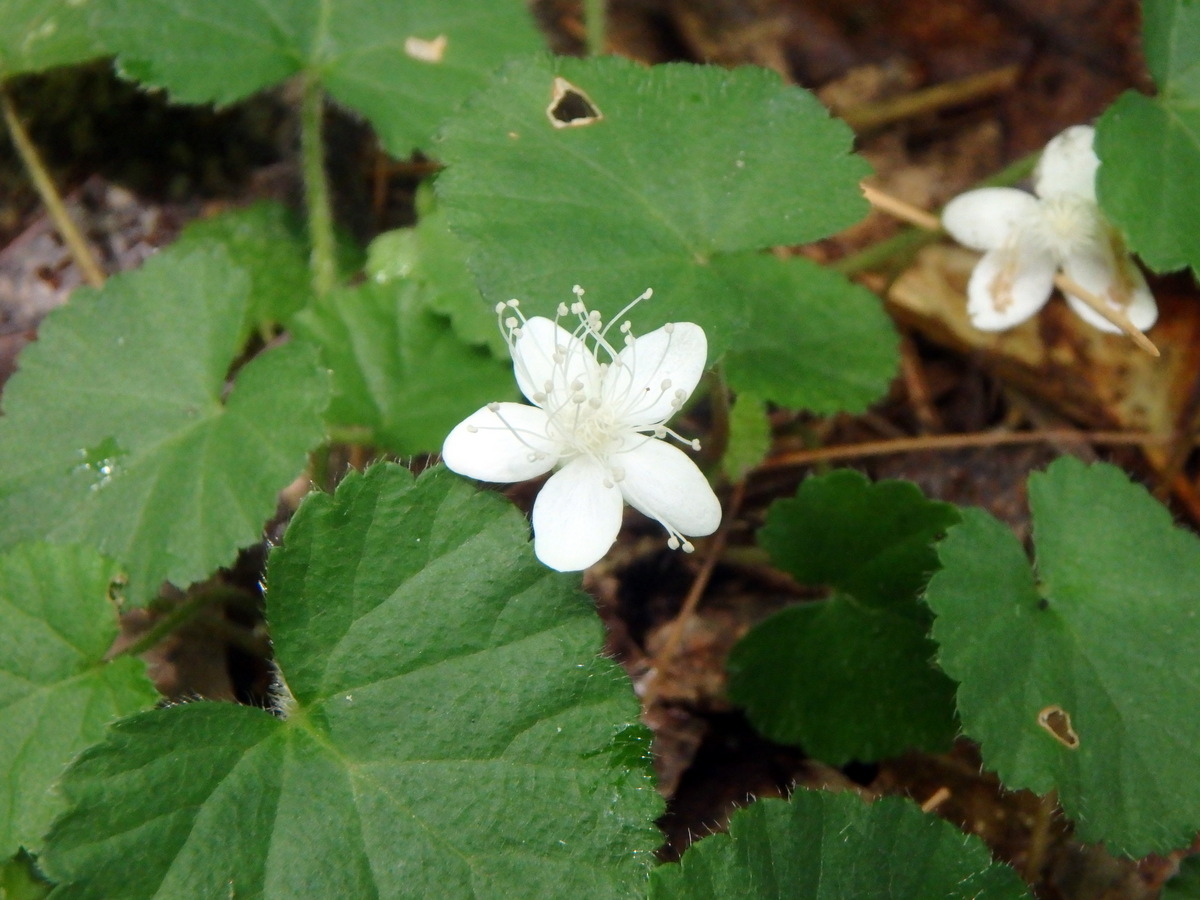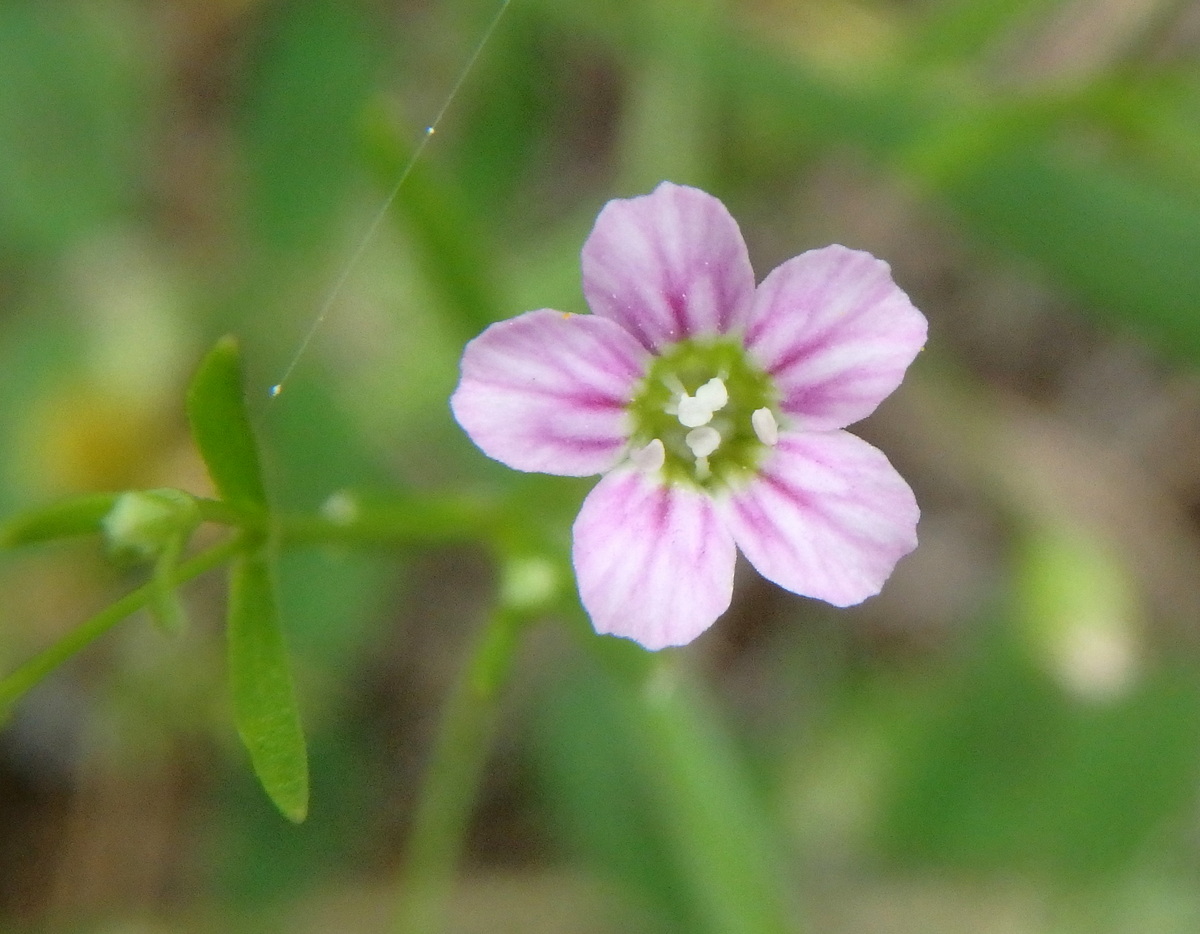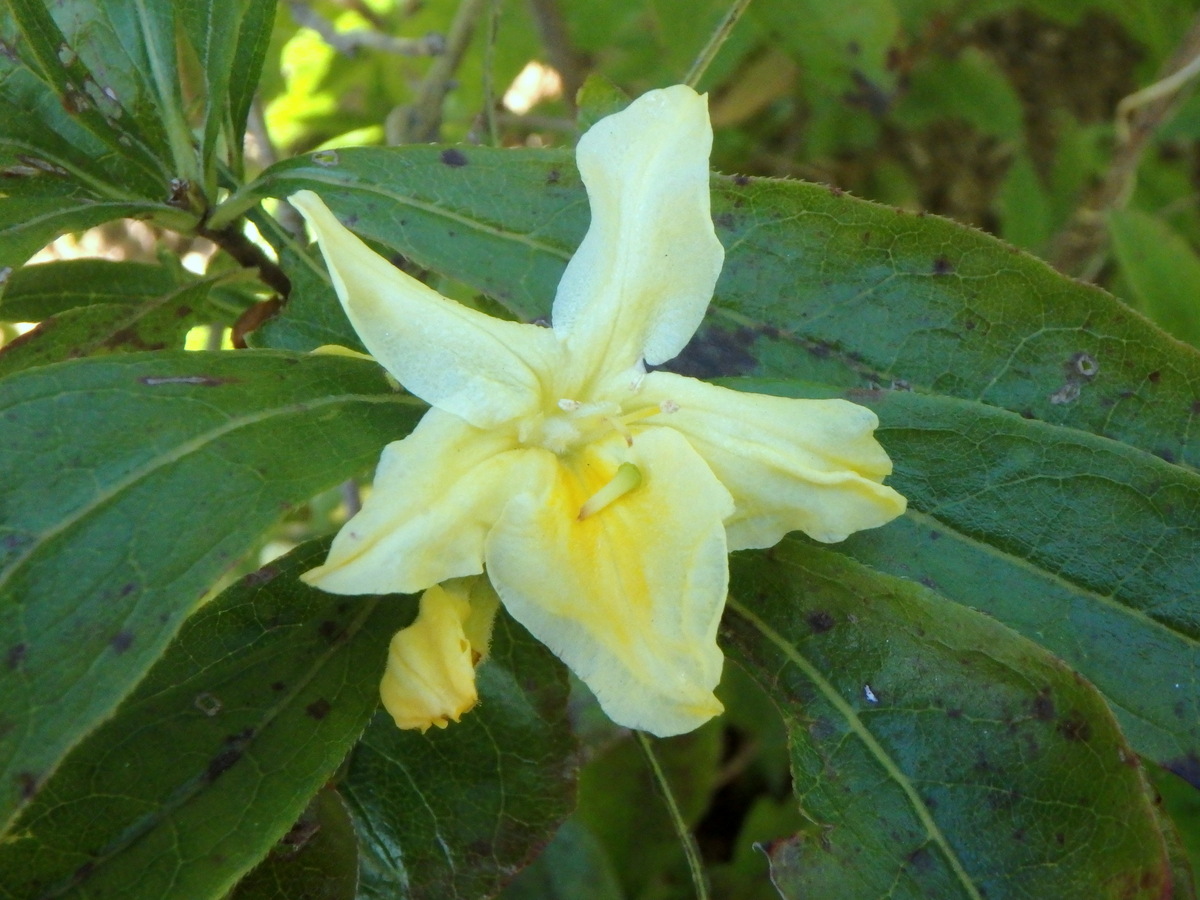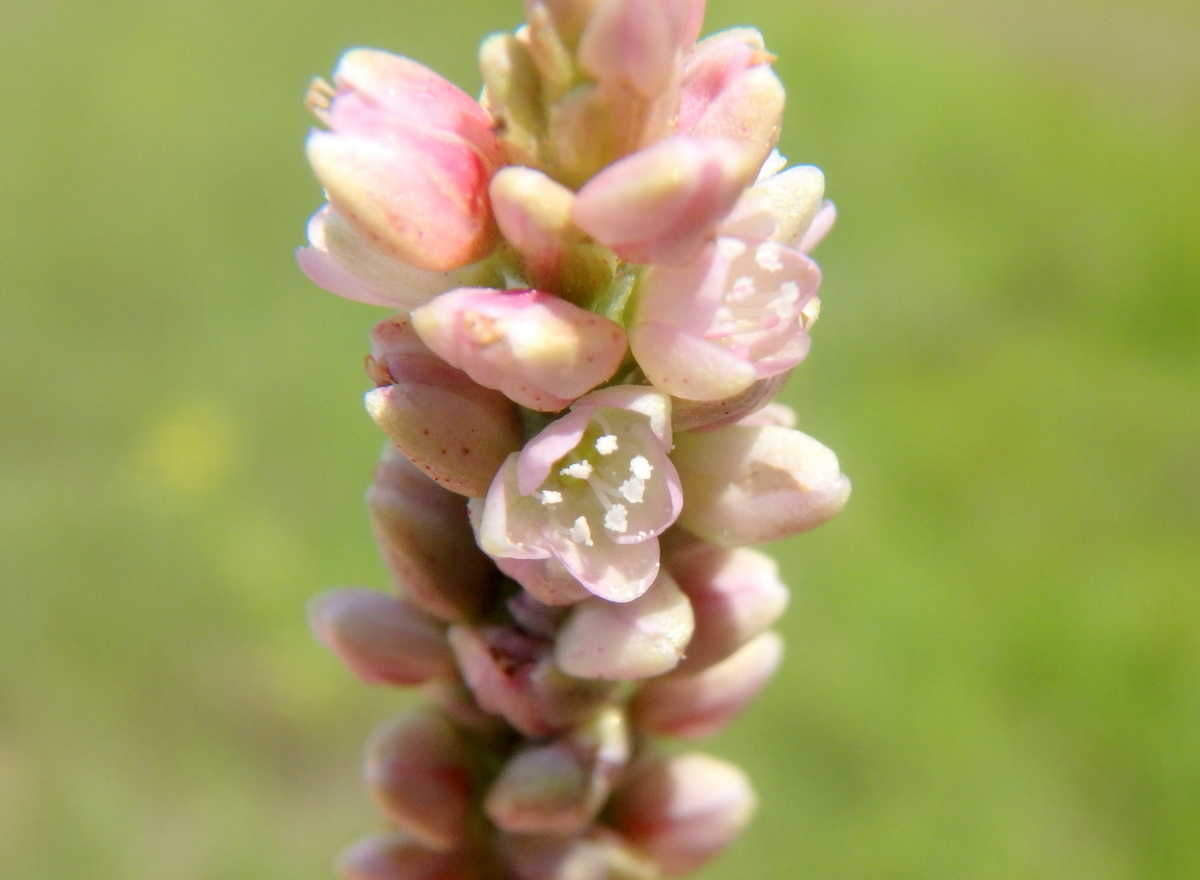
One of our prettiest wildflowers, showy tick trefoil (Desmodium canadense,) has just started blossoming. This plant grew under some powerlines where everything had been cut the previous year, so it doesn’t mind disturbed areas. It grew in full sun and was about 5 feet tall. From a distance it could fool you into thinking it was purple loosestrife but as always we get a pleasant surprise when we look a little closer. Showy tick trefoil is a legume in the bean family. This plant gets part of its common name from the little barbed hairs that cover the seed pods and make them stick to clothing like ticks. As the plant sets seeds its erect stems bend lower to the ground so the barbed seed pods can catch in the fur of passing animals.

The half inch flowers have two folded pink petals with the upper one opening first. The central white tube carries the stigmas and pistil, right there for all the insects to easily find. There is no nectar but bumblebees collect the pollen. Unfortunately Japanese beetles also love the plant.

In the same field as showy tick trefoils I found the first bull thistle (Cirsium vulgare) I’ve seen bloom this year. There were many others that weren’t even showing color so I think it’s safe to say that this plant was a little early. This plant is also called spear thistle and is a native of Europe. It is considered an invasive weed but it’s far less invasive than creeping thistle (Cirsium arvense) because it spreads itself by seeds and not root fragments like that plant does.

Many different bees and butterflies love bull thistle’s nectar and several species of small seed eating birds like finches love its seeds. Last year gold finches were all over these plants after they went to seed.

Asiatic dayflower (Commelina communis) is an introduced plant from China and Japan but it could hardly be called invasive; it seems to be quite rare here and I’m lucky if I see a dozen plants each year. It’s a colorful little thing; I love that shade of blue on the upper petals. The lower white petal is hard to see in this shot but it’s there, along with only two stamens and a long white central style.

Black swallowwort (Cynanchum louiseae) is blooming. The plant is in the milkweed family and like other milkweeds its tiny, pencil eraser size black flowers (actually very dark purple) become small green pods that will eventually turn brown and split open to release their seeds to the wind. This plant also has a sharp, hard to describe odor that is noticed when any part of it is bruised. It originally came from Europe and in 1867 Gray’s Manual of Botany reported it as “a weed escaping from gardens in the Cambridge Massachusetts area.”

This is black swallowwort’s habit. Its strong wiry stems twine around themselves and anything else in their path. That’s why in Canada it is called dog strangler vine. It breaks off at the soil level if you try to pull it, and then it grows right back again, so it is almost impossible to get rid of. Colonies of this plant have been found that covered several acres of land.

Native purple coneflowers (Echinacea purpurea) have started blooming right on time while other plants like bee balm are late. This plant is well known for its medicinal qualities as well as its beauty. According to the USDA the plant was used by many Native American tribes throughout North America to treat a variety of ailments. It was used as a pain reliever, anti-inflammatory, as a treatment for toothaches, coughs, colds, and sore throats. It was also used as an antidote for various forms of poisonings, including snake bite. Portions of it were also used to dress wounds and treat infections. Modern medicine has found it useful to combat bacterial and viral infections and as an immune system booster.

False sunflower (Heliopsis helianthoides) is a native plant that can sometimes reach 5 feet, decorated with pretty yellow, daisy like flowers. Though I often find it growing along the river it is easy to grow and also does well in gardens. Plant breeders have created at least a few cultivars. It is also called early sunflower. Watch the leaf stems (petioles) if you find it in the wild. If they are an inch and a half or more long then you might have found another native called Jerusalem artichoke (Helianthus tuberosus.) That plant also has hairy stems and false sunflower does not.

This is the first chicory flower (Cichorium intybus) I’ve seen this season. The plant by itself might not be much to look at but the flowers are always very beautiful. This one was luminous; just look at the way it glows. All flowers have a light that shines out from them but every now and then one will outshine the rest, and on this day this was the one.

These big and beautiful lilies grew in a park. Red is a hard color for most cameras to see accurately but my cell phone came through this time.

I Found a huge clump of creeping bellflower (Campanula rapunculoides) in a garden at a local park and I thought, someone is going to be sorry. That’s because once you have creeping bellflower you’ll most likely have it forever, because no amount of pulling or digging will get rid of it. It is an invasive that will choke out weaker native plants. I sometimes find it on forest edges but see it gardens more than anywhere else. The flowers are very pretty and have the unusual habit of growing all along one side of the stem. This seems to make the stems heavier on one side so they lean toward where the flowers are.

Cup plant (Silphium perfoliatum) also grows in a local park. They are tall native perennials that can reach 8 feet. It’s called cup plant because its leaf pairs-one on each side of the square stem-are fused together and form a cup around the stem. This cup usually has water in it.

I can only guess which insects come to drink from the cup plant’s tiny ponds. The plant produces resins that smell like turpentine and was used medicinally by Native Americans.

This is the first time Marshallia (Marshallia trinervia) has appeared on this blog because until this day I had never seen it. Google lens accurately identified it and when I looked it up I found that it is a native perennial plant in the daisy family called Barbara’s buttons, or broadleaf Barbara’s buttons. I don’t know who Barbara was but I thought the flowers were quite pretty and unusual. I’ve read that it grows on roadsides, bogs, or open pine woodlands but it is said to be rare, even in its native southeastern U.S. It can be found for sale at nurseries specializing in rare, unusual and / or exotic plants. I found this one in a garden at a commercial business building, of all places.

Sea holly (Eryngium planum) is another plant that has never appeared here. Since it grew in the same garden as Barbara’s buttons I’d guess that the gardener is seeking out rare and unusual plants. This one is a native of Europe and from what I’ve read likes sandy, well-drained soils in full sun.

Silvery blue sea holly flowers are tiny but look bigger because of the many long, sharp bracts that surround them. They are supposed to be especially useful for dried flower arrangements. I think it would be a conversation starter in any garden, but in this country the conversation would most likely start with “What is that?”

While it may look like a honeysuckle at first, its white latex sap might make you think it is one of the milkweeds. But those flowers aren’t milkweed flowers. In fact they’re more like dogbane flowers and that’s because this plant is indeed a dogbane called Indian hemp (Apocynum cannabinum,) which is also called dogbane hemp. It is a poisonous plant which can cause cardiac arrest if ingested but it’s also a great source of strong fibers and was used by Native Americans to make nets, bow strings, fishing lines, clothing, and twine. Some tribes also used it medicinally despite its toxicity to treat rheumatism, coughs, whooping cough, and asthma.

The pretty plum colored stems are the best clue that you’ve found Indian hemp.

Invasive shaggy soldiers (Galinsoga quadriradiata) are commonly found at the edges of vegetable gardens in this area. The plant is considered a weed, even in its native Mexico, but I think it’s worth a look. The plant is also called common quick weed or Peruvian daisy and is common in gardens, where it can reduce crop yields by as much as half if left to its own devices. The tiny flowers are about 3/8 of an inch across and have 5 white ray florets widely spaced around tiny yellow center disc florets.

Native vervain (Verbena hastata) is described as having reddish blue or violet flowers but I see a beautiful blue color. Somebody else must have seen the same thing, because they named the plant blue vervain. Vervain can get quite tall and has erect, terminal flower clusters. The plant likes wet places and I find it near ponds and ditches, as this one was. In ancient times the plant was considered a sacred plant, known for its healing powers. It has been used to treat a variety of ailments including depression, kidney stones, headaches, coughs and fevers. It is still used medicinally today by homeopaths.

Pretty vervain flowers appear on spikes sometimes 5 inches long. They are packed tightly together and bloom from the bottom of the spike to the top.

Each flower is a little less than 1/4 inch across, and has 5 evenly spaced lobes around a short, narrow tube. I’ve read that inside the tube are 4 stamens and a short style, but I’ve never seen them because it looks like they’re hidden behind a hairy trap door. An insect must have to force its way inside to get the prize. This is the first time I’ve noticed this feature on these flowers.

My favorite milkweed is swamp milkweed (Asclepias incarnata) because of the color and because of the way the flowerheads remind me of small millefiori glass paperweights. They are beautiful flowers that I can easily lose myself in. This one grows on the shore of a pond and all I had with me for a camera was my phone so though it isn’t a great shot up close, at least you can see how beautiful the plants are.
IWe are beings who seek the infinity of beauty over the finitude of time. ~J.M. Campos
Thanks for coming by.






















































































































































































